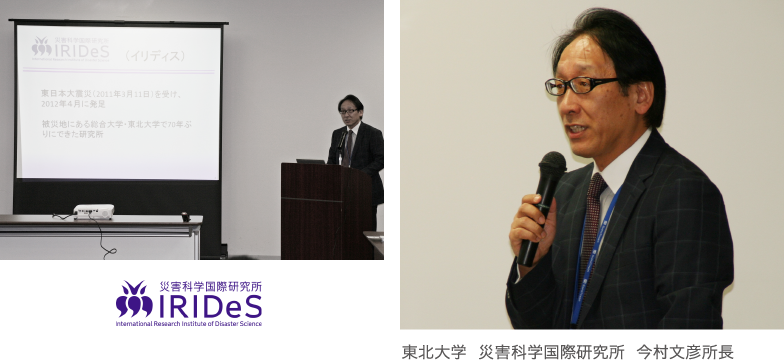Note: This website was automatically translated, so some terms or nuances may not be completely accurate.
Tohoku University, International Research Institute of Disaster Science Preparing for Mega-Disasters! Advancing Interdisciplinary Research to Evolve Disaster Prevention and Mitigation Responses
On October 1st, Tohoku University's International Research Institute of Disaster Science held the "Media Forum: Preparing for Mega-Disasters! Interdisciplinary Research to Advance Disaster Prevention and Mitigation Responses and Its Role" at the Tohoku University Tokyo Branch Office in Chiyoda Ward, Tokyo.

Aiming for practical disaster prevention science to prevent the recurrence of major disasters!
At the outset, Director Fumihiko Imamura explained the institute's founding background and overview. Established in April 2012, the institute was created to address mega-disasters that conventional disaster prevention and mitigation systems cannot handle, drawing on the experience of the unprecedented Great East Japan Earthquake. It brings together approximately 100 researchers across 7 divisions and 37 fields, characterized by comprehensive, interdisciplinary approaches spanning the humanities and sciences, such as the Disaster Risk Research Division, Disaster Medicine Research Division, and Human and Social Response Research Division.
Its mission is "Research and Practice to Prevent the Recurrence of Major Disasters." Director Mura emphasized that the institute places great importance on collaboration with numerous organizations and individuals, including domestic and international research institutions, industry, academia, government, and the private sector, to advance its research.
Recording and Passing on the Earthquake: Michinoku Shiroku Den
Associate Professor Akihiro Shibayama discussed "The Challenge of the 5th-Year Archive." The Great East Japan Earthquake Archive Project "Michinoku Shiroku-den" is a project to "record and pass on the earthquake." Centered around the institute, it advances with the cooperation of disaster survivors, local governments, NPOs, and in collaboration with over 120 institutions from industry, government, and academia.
In January 2012, the "Michinoku: Passing on the Present Team" was formed, consisting of local residents from 15 municipalities along the Miyagi coast. Approximately 100,000 photographs and testimony records from over 3,000 individuals have been collected. The team investigates and documents the current state of the disaster-affected areas and what should be passed on to future generations, publishing this information on Facebook and the web.
The project also focuses on activities to convey experiences and lessons learned, continuously holding exhibitions, workshops, storytelling events, and symposiums.
Approximately 400,000 disaster-related records have been accumulated. These can be viewed at the National Diet Library's Great East Japan Earthquake Archive "Higanbana".
Mental Health Preparedness: For Yourself and for Support Systems
Professor Hiroaki Tomita discussed "The Reality of Mental Health After the Great East Japan Earthquake and the Development of Future 'Mental Disaster Preparedness' Systems."
The professor conducted longitudinal surveys on disaster stress in Shichigahama Town, Miyagi Prefecture, from 2011 to 2014. He reported that the proportion of people experiencing stress remained around 30% between 2011 and 2014. While some individuals saw their stress alleviate, others began reporting new stress symptoms several years later.
The survey also revealed that individuals may develop mental health conditions like post-traumatic stress disorder without realizing it themselves. Professor Kuroda emphasized the importance of establishing "mental disaster preparedness" systems, such as creating environments that make it easier to consult mental health professionals through collaboration with government agencies, public health nurses, and other support organizations.
Contributing Globally through the Establishment of the Global Center for Disaster Statistics
As an international research institute, the center leverages its strengths—including experience from the Great East Japan Earthquake, data, and numerical models—to conduct research in collaboration with universities and research institutions worldwide. It also focuses on overseas academic support while conducting emergency disaster surveys abroad.
Professor Hiroaki Marutani explained the "Global Center for Disaster Statistics," established within the institute in April 2015 as an international initiative. The decision to establish the center was driven by the belief that effective disaster prevention policies cannot be formulated without understanding the actual state of disasters, especially given that many countries currently lack disaster damage statistics.
The Center has a track record of supporting the construction of disaster statistics databases in over 82 countries worldwide. It will advance projects in collaboration with the United Nations Development Programme (UNDP), which maintains strong connections with relevant agencies in various countries.
Professor Kuroda expressed his enthusiasm, stating, "Going forward, we aim to contribute to national disaster prevention policies by aggregating and archiving disaster statistics from various countries into the Center's global database and analyzing this disaster statistics data."
Was this article helpful?